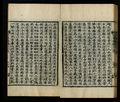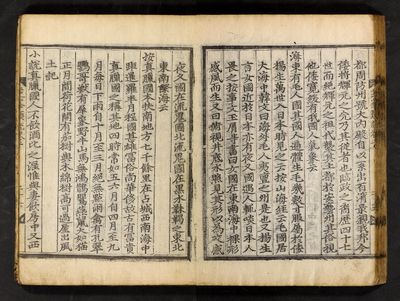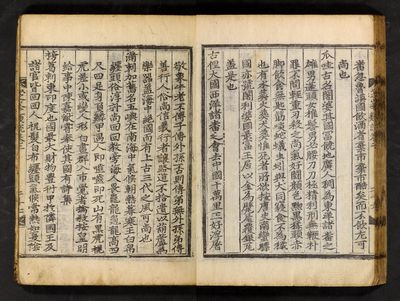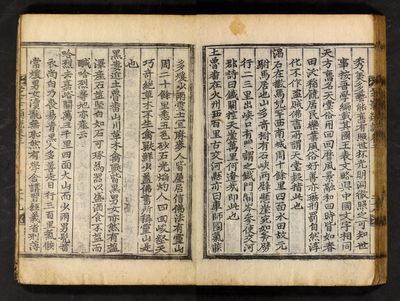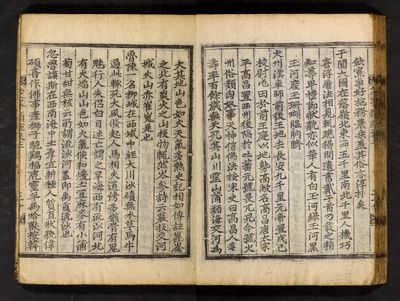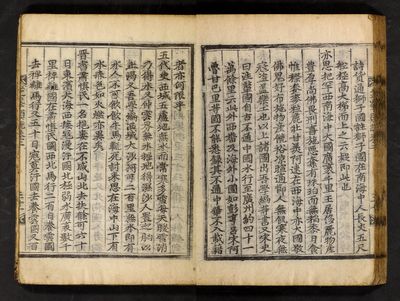"(Translation) 李睟光 外國3"의 두 판 사이의 차이
Arts.jhlee (토론 | 기여) (→Student 10 : (Ji-Hyun Lee)) |
|||
| 35번째 줄: | 35번째 줄: | ||
{|class="wikitable" style="width:100%; background-color:#ffffff;" | {|class="wikitable" style="width:100%; background-color:#ffffff;" | ||
| − | !style="width:25%;"|Image || style="width: | + | !style="width:25%;"|Image || style="width:75%;"|Text |
|- | |- | ||
| 46번째 줄: | 46번째 줄: | ||
19. 小說。眞臘國人。不飮酒比之淫。惟與妻飮房中。又西 | 19. 小說。眞臘國人。不飮酒比之淫。惟與妻飮房中。又西 | ||
| − | + | ||
| − | |||
|- | |- | ||
| [[File:지봉유설권2외국8.jpg |border|지봉유설권2외국8|400px]] | | [[File:지봉유설권2외국8.jpg |border|지봉유설권2외국8|400px]] | ||
| 60번째 줄: | 59번째 줄: | ||
23. 榜葛剌。東印度也。國最大。財物豐衍。甲於隣國。王及諸官。皆回回人。祝髮白布纏頭。氣候常熱如夏。陰 | 23. 榜葛剌。東印度也。國最大。財物豐衍。甲於隣國。王及諸官。皆回回人。祝髮白布纏頭。氣候常熱如夏。陰 | ||
| − | + | ||
| − | |||
|- | |- | ||
| [[File:지봉유설권2외국9.jpg |border|지봉유설권2외국9|400px]] | | [[File:지봉유설권2외국9.jpg |border|지봉유설권2외국9|400px]] | ||
| 72번째 줄: | 70번째 줄: | ||
26. 撒馬兒罕。漢罽賓也。去嘉峪關萬里。東西相距千里。風景偉麗。土田膏腴。頗類中原。西南番賈多聚於此。俗尚回回敎。有拜天屋。靑石雕鏤極精巧。人物 | 26. 撒馬兒罕。漢罽賓也。去嘉峪關萬里。東西相距千里。風景偉麗。土田膏腴。頗類中原。西南番賈多聚於此。俗尚回回敎。有拜天屋。靑石雕鏤極精巧。人物 | ||
| − | + | ||
| − | |||
|- | |- | ||
| [[File:지봉유설권2외국10.jpg |border|지봉유설권2외국10|400px]] | | [[File:지봉유설권2외국10.jpg |border|지봉유설권2외국10|400px]] | ||
| 88번째 줄: | 85번째 줄: | ||
31. 哈烈。去嘉峪關萬三千里。四面大山而少雨。男髡首。衣尚白。乃喪易靑黑。人多善走。日行三百里。氣候常煖。男女瀆亂無恥。然有學舍。講習經義。省刑薄 | 31. 哈烈。去嘉峪關萬三千里。四面大山而少雨。男髡首。衣尚白。乃喪易靑黑。人多善走。日行三百里。氣候常煖。男女瀆亂無恥。然有學舍。講習經義。省刑薄 | ||
| − | + | ||
| − | |||
|- | |- | ||
| [[File:지봉유설권2외국11.jpg |border|지봉유설권2외국11|400px]] | | [[File:지봉유설권2외국11.jpg |border|지봉유설권2외국11|400px]] | ||
| 102번째 줄: | 98번째 줄: | ||
35. 忽魯謨斯。在西南海中。土厚宜耕種。人質直。狀貌偉碩。喜作佛事。産獅子駞鷄福鹿靈羊馬哈獸。按韓 | 35. 忽魯謨斯。在西南海中。土厚宜耕種。人質直。狀貌偉碩。喜作佛事。産獅子駞鷄福鹿靈羊馬哈獸。按韓 | ||
| − | + | ||
| − | |||
|- | |- | ||
| [[File:지봉유설권2외국12.jpg |border|지봉유설권2외국12|400px]] | | [[File:지봉유설권2외국12.jpg |border|지봉유설권2외국12|400px]] | ||
| 109번째 줄: | 104번째 줄: | ||
詩貨通獅子國註。獅子國在南海中。人長丈五尺。船極高大。梯而上之云。疑卽此也。 | 詩貨通獅子國註。獅子國在南海中。人長丈五尺。船極高大。梯而上之云。疑卽此也。 | ||
| − | + | ||
| − | |||
|- | |- | ||
|} | |} | ||
| − | + | <!-- | |
=='''Discussion Questions'''== | =='''Discussion Questions'''== | ||
# | # | ||
| 120번째 줄: | 114번째 줄: | ||
=='''Further Readings'''== | =='''Further Readings'''== | ||
| − | + | ||
<div style="color:#008080;"> | <div style="color:#008080;"> | ||
* View together with '''~~'''. | * View together with '''~~'''. | ||
</div> | </div> | ||
| − | + | ||
* | * | ||
* | * | ||
| 555번째 줄: | 549번째 줄: | ||
[[Category:2018 Hanmun Summer Workshop]] | [[Category:2018 Hanmun Summer Workshop]] | ||
[[Category:Advanced Translation Group]] | [[Category:Advanced Translation Group]] | ||
| + | --> | ||
2022년 2월 15일 (화) 00:58 기준 최신판
| Primary Source | ||
|---|---|---|
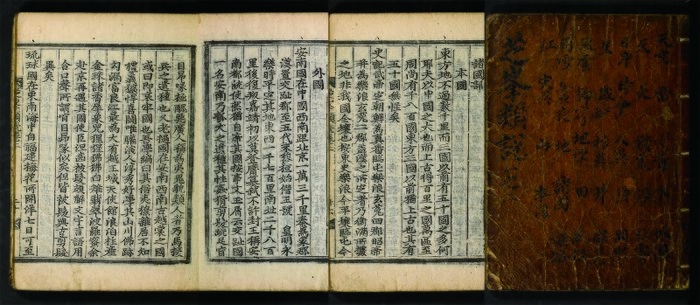 |
Title | |
| English | ||
| Chinese | 芝峯類說 | |
| Korean(RR) | 지봉유설(Jibongyuseol) | |
| Text Details | ||
| Genre | Literati Writings | |
| Type | ||
| Author(s) | 李睟光 | |
| Year | ||
| Source | ||
| Key Concepts | ||
| Translation Info | ||
| Translator(s) | Participants of 2018 Summer Hanmun Workshop (Advanced Translation Group) | |
| Editor(s) | ||
| Year | 2018 | |
Introduction
In this section of on Foreign Countries(外國), Isugwang lists countries ranging from those around Japan all the way up to the Islamic world around the central Asia.
One interesting point is that here he mixed empirical record and thing that seems fantastical to us. However, based on his assertion in his own preface, he might well have taken all of these description to be faithful to the reality in some sense. In his preface, he says "as to the things mythical and strange, I did not record a single item(若事涉神怪者, 一切不錄)."[1] Thus, things such as the Country of Beasts and black tigers that transforms into human shapes might have been real enough to be recorded in his book.
As for the apparently fantastic countries, he seems to have been affected by both the Classic of Mountains and Seas(山海經, Shanhaijing) and Matteo Ricci's Complete Geographical Map of Ten Thousand Countries(Kunyu wanguo quantu 坤輿萬國全圖)." Ricci himself incorporated the fantastic animals and countries in his new world map. For example, the Country of Beasts Isugwang describes is located on the northeast of Japan near the North Pole in Ricci's map. This location roughly matches Isugwang's description. According to a research on 坤輿萬國全圖, Ricci was also using the Classic of Mountains and Seas to supplement the information he heard from the European explorers.[2]
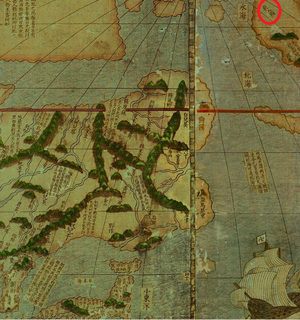
Original Script
- ↑ "자서(自序)." http://www.krpia.co.kr/viewer?plctId=PLCT00004513&tabNodeId=NODE04082994#none
- ↑ Zhang, Qiong. 2015. Making the New World Their Own: Chinese Encounter with Jesuit Science in the Age of Discovery. Leiden: Brill. pp.73-35.
- ↑ https://artsandculture.google.com/asset/%EC%8B%A0%EA%B3%A4%EC%97%AC%EB%A7%8C%EA%B5%AD%EC%A0%84%EB%8F%84-%E6%96%B0%E5%9D%A4%E8%88%87%E8%90%AC%E5%9C%8B%E5%85%A8%E5%9C%96/twGEi2Om9Nmouw?ms=%7B%22x%22%3A0.49989971418491963%2C%22y%22%3A0.18538077425881158%2C%22z%22%3A12.006697790604882%2C%22size%22%3A%7B%22width%22%3A0.2273922011013367%2C%22height%22%3A0.3003427245780979%7D%7D
